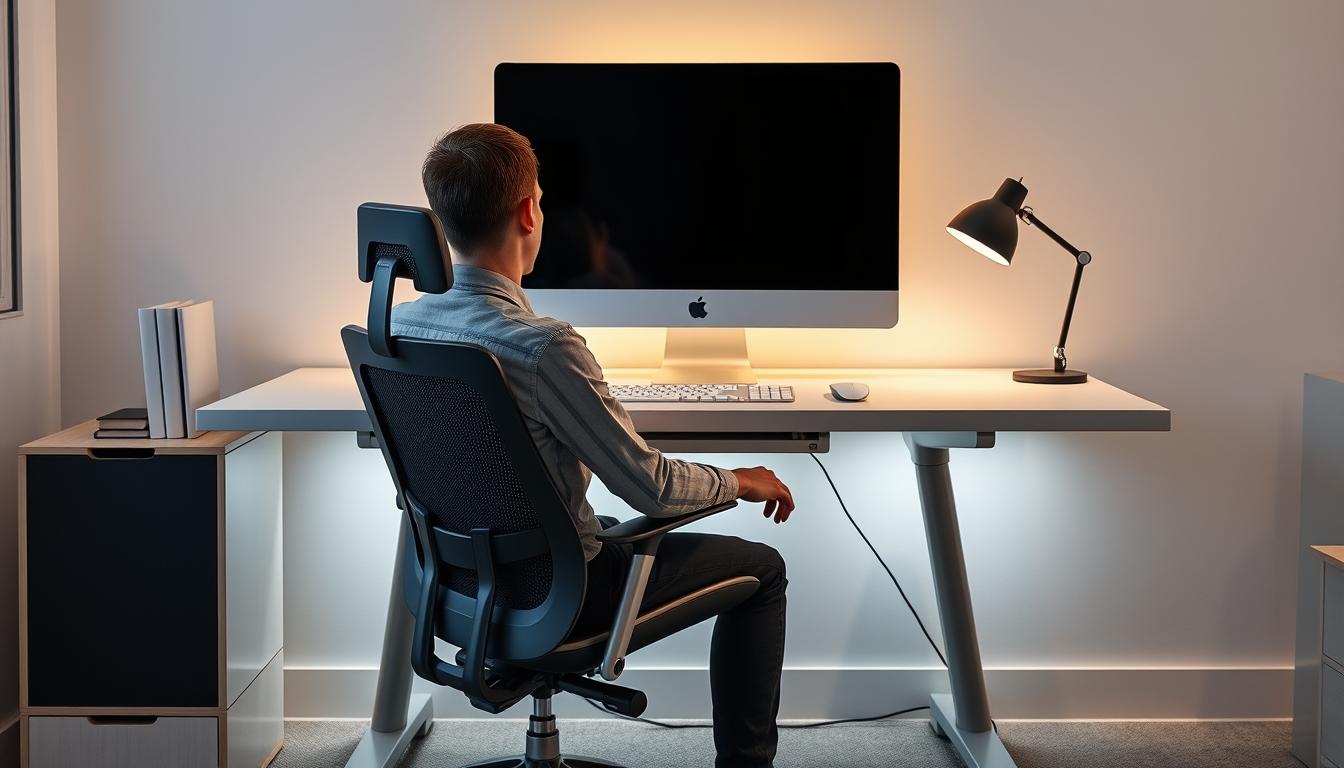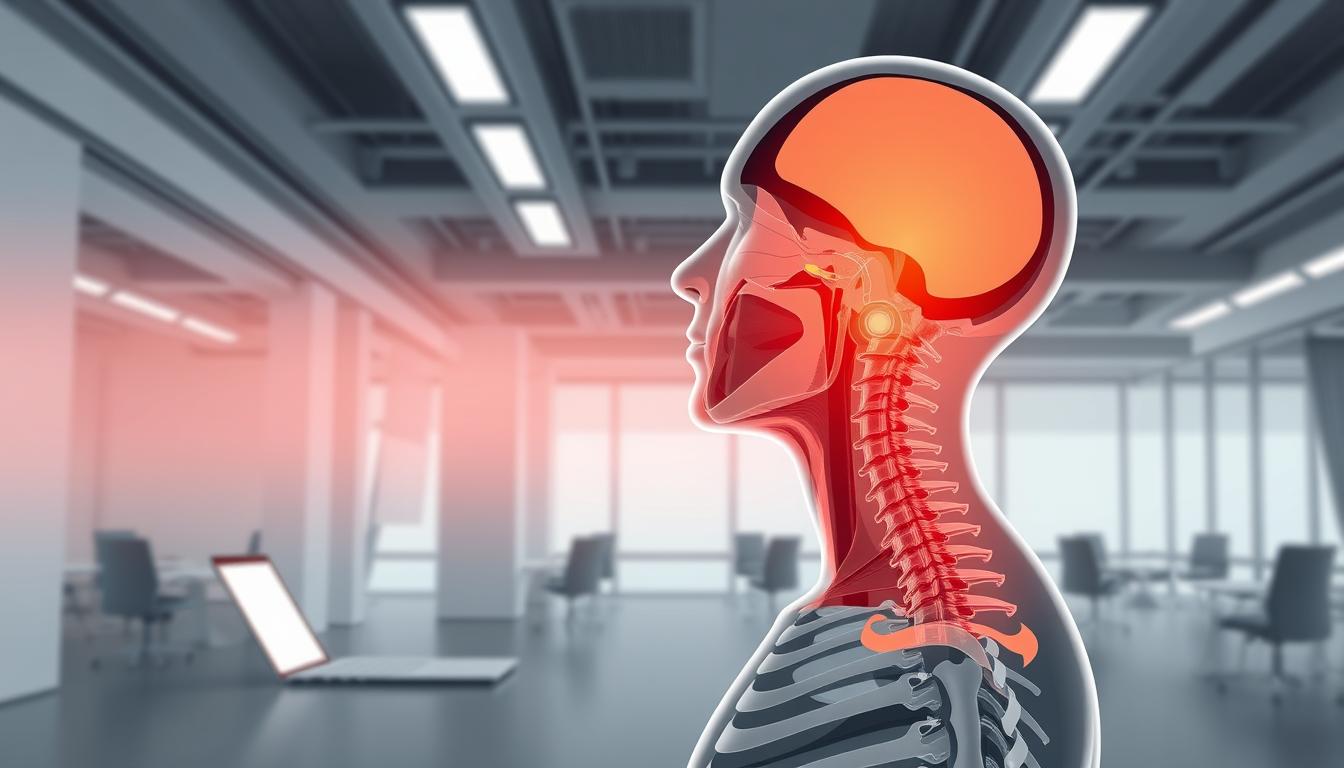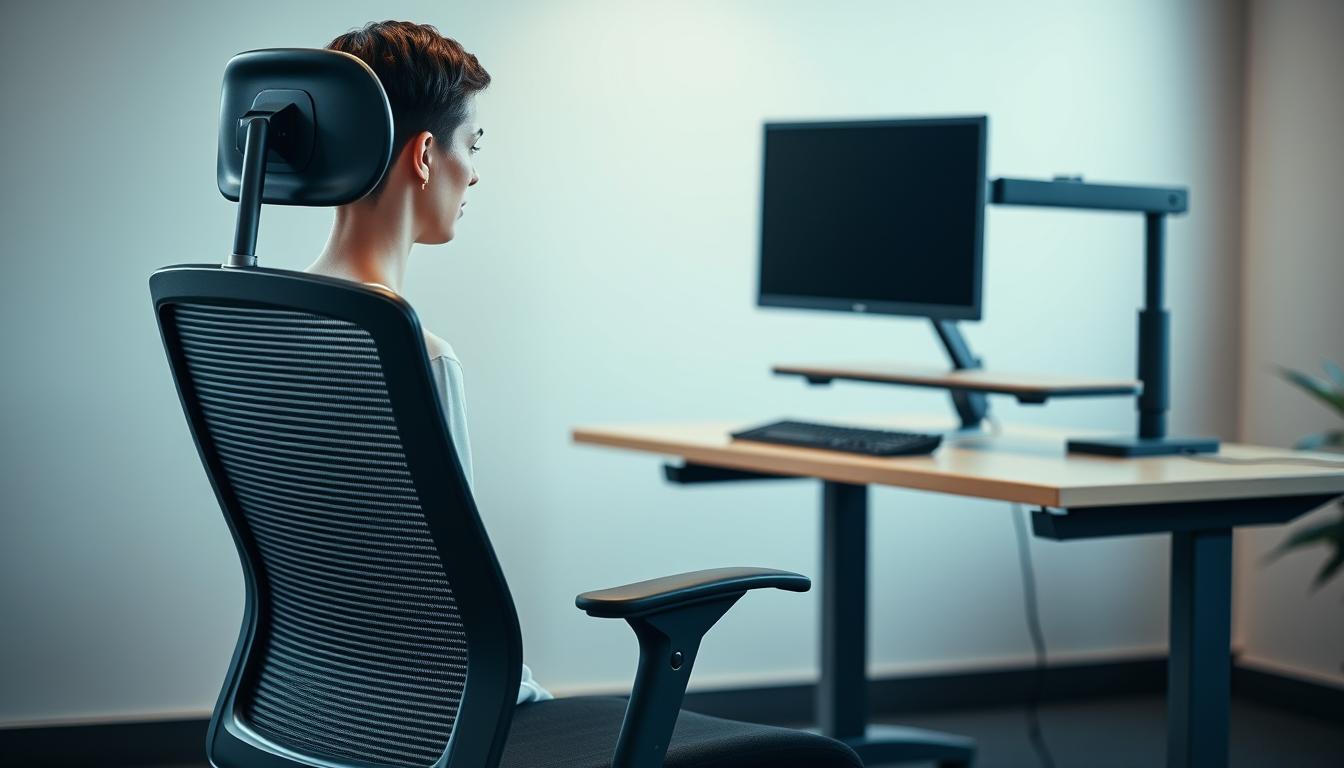Finding the ideal chair height is vital for neck health in today’s office settings. An ergonomic workspace boosts comfort and wellness for those who sit for long hours. Poorly adjusted chair height can cause strain, harming posture and neck health.
Understanding the Importance of Chair Height
The height of your chair is key for keeping a good posture and neck health. An improperly adjusted chair can cause muscle strains and ongoing neck pain. It’s important to have your chair at the right height to reduce stress on your neck spine. This helps avoid discomfort throughout your day.
The Relationship Between Chair Height and Neck Health
The right chair height is crucial for your neck and spine alignment. If it’s too low or high, you might lean forward or strain your neck. This can lead to neck pain. Studies show that sitting right can lower the pressure on your neck muscles.
Common Neck Problems Associated with Poor Chair Height
Wrong chair height can lead to various neck problems, such as:
- Tech neck, often caused by prolonged screen time without proper support.
- Stiffness, leading to challenges in head movement.
- General discomfort due to poor ergonomic posture.
Knowing the importance of chair height helps. You can adjust your workspace to prevent neck issues. It’s about making your place better for your health.
The Ideal Chair Height for Neck Health
It’s important to find the right chair height for your neck health and comfort. The right measurement supports your body well. Your feet should be flat on the floor, with your knees at a right angle.
How to Measure Your Ideal Chair Height
To find the right chair height, here are easy steps:
- Sit with your back against the chair.
- Your feet should touch the ground, and knees bent at a right angle.
- The top of the seat cushion should be just under your kneecap.
This way of measuring helps you find adjustable chairs that fit you.
Adjustability for Different Body Sizes
Chairs aren’t one-size-fits-all. Ergonomic chairs with adjustable height are key to supporting different body types. They let you customize the fit. This helps align your body right, avoiding discomfort or pain. With these chairs, everyone can find their perfect height, keeping their neck healthy.
Key Features of an Ergonomic Chair
Choosing an ergonomic chair can really help your neck and back feel better. Features like lumbar support and armrest adjustments are key for comfort and posture. Let’s explore how these parts make a difference.
Lumbar Support: Essential for Neck and Back Health
Lumbar support is crucial in any ergonomic chair. It keeps the lower back’s natural curve and spreads your weight evenly. Chairs with good lumbar support lessen spine strain and stop neck and back pain. They also come with options to adjust the support to fit your body.
Armrest Adjustability and Its Role in Neck Alignment
Being able to adjust armrests is important for keeping your neck aligned. Chairs with adjustable armrests let you set them at the right height. This reduces shoulder tension and helps you sit more comfortably. The right armrest setting can ease neck strain and boost comfort when sitting for long periods. Picking a chair with these features can make working more enjoyable and keep you healthier.
Desk Height: An Often Overlooked Component
Having a desk setup that is ergonomic is key to keeping a good posture. It also helps in lessening strain when working for hours. The right fit between your desk and chair height is crucial. With the right adjustments, you can sit in a way that’s both comfortable and makes you more productive.
Relation Between Desk and Chair Height for Optimal Posture
The height of your desk is crucial to keep your elbows in line with or a bit above your desk. This stance helps lower tension in your shoulders and neck, which is good for your health. Since everyone is different, it’s important to adjust your desk and chair to fit you perfectly. This is the secret to a great desk setup.
Using Footrests for Enhanced Comfort
Sometimes, even with a chair that adjusts, you might need extra support for your legs. A footrest can help lift your feet so your knees are bent comfortably. This can ease pressure on your thighs. Using a footrest can help keep blood flowing right and keep you from getting too tired while working.
Optimal Workspace Setup for Neck Health
A neat workspace setup is key to keeping your neck happy. Putting your monitor and keyboard just right can lessen strain and make you more efficient. Here’s how to make your workspace better for your neck and overall health.
Monitor Height and Distance Recommendations
To place your monitor correctly, the top should be at or just below your eye level. This keeps your neck neutral. Keep the screen about an arm’s length away to avoid strain. Tilt the monitor to cut down on glare and see better, which is important for a good setup.
Keyboard and Mouse Positioning to Prevent Strain
When setting up your keyboard, keep your elbows near your body and your wrists straight. This avoids uncomfortable angles that can hurt over time. Make sure your keyboard and mouse are level to keep your forearms straight. This boosts efficiency and helps keep your neck and shoulders relaxed.
Incorporating Movement into Your Workday
Add movement into your daily work life to ease neck pain and boost your health. Moving regularly makes your neck healthier. Taking breaks during the day helps workers relax and stops muscles from getting tense.
The Benefits of Taking Breaks for Neck Health
Taking short breaks often is great for your neck. These breaks relax muscles that work too hard and fight the bad effects of sitting too long. You’ll get better blood flow, clearer thinking, and less chance of neck pain.
- Increased blood circulation to reduce muscle stiffness.
- Enhanced mental clarity and focus.
- Lower risk of developing chronic neck pain.
Exercises to Support Neck and Upper Body Muscles
Adding exercises for your neck into your day strengthens your whole upper body and betters your posture. Try these exercises:
- Neck Tilts: Gently tilt your head towards each shoulder, holding for a few seconds to stretch the muscles.
- Shoulder Rolls: Roll your shoulders forwards and backwards to relieve tension and promote blood flow.
- Wall Angels: Stand against a wall and slide your arms up and down while keeping your lower back pressed against the wall.

Choosing the Right Office Chair
Finding the perfect office chair means looking at features that keep you comfy and healthy. It’s key to pick a chair that works just for you, focusing on how it can adjust to meet your needs.
Features to Look for in Ergonomic Chairs
Keep an eye out for these important features:
- Adjustable Height: Being able to change the chair’s height makes sure your feet can stay flat on the ground. This helps keep your body in the right position.
- Lumbar Support: Support for your lower back is essential. It keeps your spine happy and prevents your neck from getting sore.
- Armrest Flexibility: Armrests that adjust can lower stress on your shoulders. This lets you keep a better posture while you work.
Adjustable vs. Non-adjustable Chairs: Which Is Better?
Adjustable chairs are more flexible than ones that can’t adjust. They let you change things like height and back support to fit your body and how you work. Having an adjustable chair means it can suit more people, making it a smart choice for shared spaces. Buying an adjustable chair is worth it for the better comfort and support it offers for long hours of sitting.
Maintenance of Chair Ergonomics
Keeping your office chair ergonomic is key for comfort and health during long sitting hours. As we change, so should our chairs to fit us right. Adjusting your chair for better ergonomics means more comfort and a healthier work space.
Regular Adjustments as Your Body Changes
Body posture changes over time due to factors like getting older, gaining weight, or how active you are. It’s important to check and tweak chair settings now and then. Focus on key adjustments such as:
- Height adjustments for perfect desk alignment
- Backrest settings for strong lumbar support
- Armrest height for comfy shoulders and arms
How to Maintain Your Chair for Lasting Comfort
Maintaining your chair is more than just making adjustments. For comfort that lasts, keep these tips in mind:
- Clean the chair’s surface to get rid of dust and dirt.
- Check wheels and levers to make sure they work smoothly.
- Change old cushioning to keep up good support.
Looking after your chair and making necessary adjustments ensures it stays comfy and supportive. A well-kept chair is great for your health and helps you do better at work.
Conclusion
The right chair height is super important for keeping our necks healthy. It helps make sure our neck and spine stay in line. This prevents problems caused by sitting wrong. We’ve shared tips on keeping your neck healthy and how the right workspace setup can make a big difference.
Choosing an ergonomic workspace means more than just picking a chair of the right height. It also includes having a desk of the correct height, placing your monitor right, and taking proper breaks. These things help you sit better and put less strain on your body. By doing this, you’ll feel more comfortable and might get more work done.
When you make these changes to your workspace, you’re looking out for your body’s health. Staying committed to a well-set-up workspace can improve your neck’s health. It can make your overall life at work better too.



